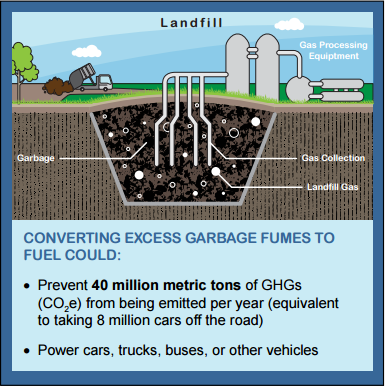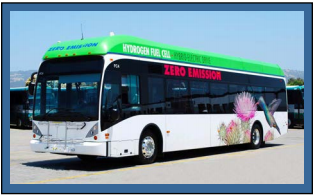What if Garbage Fumes Powered More of Our Cars, Trucks, and Buses?
 There are over 1,000 large landfills in the United States1. If you’ve ever driven past one, your nose will tell you that those piles of garbage are emitting gas. Landfill gas, which is a biogas— composed primarily of methane and carbon dioxide—isn’t just stinky, it also contributes to global climate change. Large landfills are required to collect and burn their biogas to reduce the amount of unhealthy fumes they emit. But biogas has more beneficial uses. It can be converted to compressed natural gas or hydrogen, or be used to generate electricity. As more and more cars, trucks, and buses start to operate on these alternative fuels, it seems a waste to send any of our biogas up in smoke. What if we converted all available U.S. garbage fumes from large landfills into transportation fuel?
There are over 1,000 large landfills in the United States1. If you’ve ever driven past one, your nose will tell you that those piles of garbage are emitting gas. Landfill gas, which is a biogas— composed primarily of methane and carbon dioxide—isn’t just stinky, it also contributes to global climate change. Large landfills are required to collect and burn their biogas to reduce the amount of unhealthy fumes they emit. But biogas has more beneficial uses. It can be converted to compressed natural gas or hydrogen, or be used to generate electricity. As more and more cars, trucks, and buses start to operate on these alternative fuels, it seems a waste to send any of our biogas up in smoke. What if we converted all available U.S. garbage fumes from large landfills into transportation fuel?
What's the bottom line? 
Some U.S. landfills are already collecting biogas for use in energy projects2. EPA estimates that there are about 450 landfills with untapped potential to use their garbage fumes. These landfills could collect an approximate total of 475 million cubic feet of biogas per day — enough to fill nearly a billion party balloons.
If we converted all this biogas to transportation fuel, we could prevent about 40 million metric tons of direct GHG emissions (CO2e) from being released each year, equivalent to taking 8 million cars off the road.3
Plus, because we are displacing gasoline or diesel, we would also reduce lifecycle GHG emissions associated with producing and distributing the fuel used by those vehicles.
What would it be like?
If your local landfill is large, it may be emitting enough gas to produce up to 3,200 gallons gasoline equivalent (GGE) of transportation fuel each day. (One GGE is the amount of fuel that contains the same energy as one gallon of gasoline.) How many vehicles would this power?

*The higher number of electric cars (EVs) reflects both that cars consume less fuel per mile than garbage trucks or buses and that EVs today have a limited driving range per battery charge. We assumed a fully charged EV battery would power about 100 miles of driving.
Here are a few real-world examples of how this can work.
- Powering Garbage Trucks with CNG: Garbage trucks may already be driving around your neighborhood collecting what eventually will be their own fuel. Once a landfill puts a process in place to turn landfill gas into CNG, a typical, large landfill could fuel 40 natural gas powered garbage trucks in its fleet or sell CNG to a neighboring town to bring in revenue.
 Powering a City’s Taxi Fleet with Electricity: A landfill collects its fumes, which are then burned to create electricity on site. This electricity could charge over a thousand electric taxis or other all-electric vehicles (for one battery charge each day). Because electric cars are significantly more fuel efficient than gasoline cars and have no tailpipe emissions, the city would reduce even more GHGs.
Powering a City’s Taxi Fleet with Electricity: A landfill collects its fumes, which are then burned to create electricity on site. This electricity could charge over a thousand electric taxis or other all-electric vehicles (for one battery charge each day). Because electric cars are significantly more fuel efficient than gasoline cars and have no tailpipe emissions, the city would reduce even more GHGs.- Powering Municipal Buses with Hydrogen: A typical landfill could install a reformer or gasifier to produce enough hydrogen to fill 45 municipal fuel cell buses. These buses have zero harmful tailpipe emissions, which means your trash would actually be helping your family and neighbors breathe cleaner air.
Even more opportunities will emerge as additional cars, trucks, and buses that use advanced fuels enter the market. So, next time you are driving by a landfill, don’t just think, “Ewww!” think, “smells like a refueling opportunity!”
A PDF version of this page, optimized for printing
What If Garbage Fumes Powered More of Our Cars, Trucks, and Buses? (PDF) (2 pp, 1.27 MB, EPA-420-F-15-020, September 2015, About PDF)
- U.S. Environmental Protection Agency, Landfill Methane Outreach Program (LMOP), March 2015 database, available at epa.gov/lmop/
- Projects include electricity generation for power plants and manufacturing facilities as well as the production of various transportation fuels including biofuels.
- Vehicles that can operate on fuel produced from landfill biogas are currently in limited production. Additional vehicles and specialized refueling infrastructure would be needed to utilize all of this biogas.
- We assumed 0.0030 GGE of CNG is produced per standard cubic foot of landfill gas, see LMOP’s calculator LFGcost-Web V3.0, available at epa.gov/lmop/lfgcost-web-landfill-gas-energy-cost-model. We assumed a 70% efficiency for converting natural gas to hydrogen and that 113,400 Btu = 1 kg of hydrogen. We did not account for fuel loss during compression of hydrogen gas. Our electricity estimate is from the LMOP Interactive Conversion Tool and the LMOP March 2015 database, both available at epa.gov/lmop/. We also assume 1 gallon of gasoline equivalent = 33.7 kW-hrs and that the fuel economy of an electric vehicle is 100 MPGe or 34 kW-hrs per 100 miles.
- We assumed the following fuel tank capacities: CNG garbage truck = 70 diesel gallon equivalent and hydrogen fuel cell bus = 50 kg. We assumed an EV requires 34 kW-hrs of electricity to fully charge the battery.
